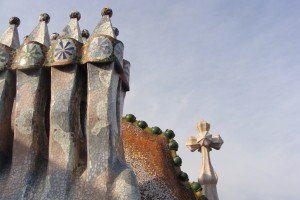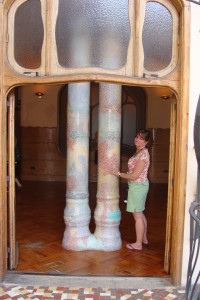After witnessing a young man’s tragic fall, Darcy Rhyno tries to gauge how close to death he is willing to come, in deed and in word.
4. The New Life
 On the way down into Barcelona from Parc Güell on the number 24 bus, I told my partner Alison I would have gladly given up my sanity if I could have saved the fallen young man. To hold his shattered skull together with my hands… I would have gladly traded this for the nightmares that would surely have followed. If I were him, I’d want the same, I’d want someone to sacrifice that artificial distance we keep from death, the way we hold ourselves off from it as if doing so might save our own lives. This is how I came to despise Pamuk and the characters he created. Unlike his character, I hadn’t wanted to be close to death for my own sake, but for the sake of a fellow traveller.
On the way down into Barcelona from Parc Güell on the number 24 bus, I told my partner Alison I would have gladly given up my sanity if I could have saved the fallen young man. To hold his shattered skull together with my hands… I would have gladly traded this for the nightmares that would surely have followed. If I were him, I’d want the same, I’d want someone to sacrifice that artificial distance we keep from death, the way we hold ourselves off from it as if doing so might save our own lives. This is how I came to despise Pamuk and the characters he created. Unlike his character, I hadn’t wanted to be close to death for my own sake, but for the sake of a fellow traveller.
Like everyone else, I live much of my life in my imagination, a symbolic world in which everything is itself and something else as well. As a writer, I spend considerable time and effort recording that imagined life, creating those symbolic characters, organizing a world in which I have ordered events to make sense of the randomness of life. Perhaps this is why Pamuk’s thesis in The New Life that writing has alienated us from life and death – as they have alienated one from the other – struck me so powerfully that I felt my life had changed as a result of reading the book. Because writing is metaphor, Pamuk’s character theorizes, because in writing everything is something else and not itself, writing and words have removed us from experience by at least a single, definitive step. Only proximity to death can strip life of the metaphors and false meanings that separate us from it so we see it without words, feel it for what it is.
 The 24 bus runs along Passeig de Gràcia or Gràcia Promenade, home of two great Gaudi buildings – Casa Batlló and Casa Milà, aka The Quarry – both of which we’d visited the day before. It was Casa Batlló, known as The House of Bones for its skeletal qualities, that affected me most. There is simply nothing else like it on this planet. It’s as if Gaudi challenged himself to build his creation – a private home he completed in 1906 for a wealthy family – without a single straight line. The balconies overlooking the street resemble reptilian skulls, the columns supporting them look like bones, the roof of ceramic tiles a dragon’s arched back. Many believe the turret to the left of this suggestive roof line crowned with Gaudi’s unique four-sided cross represents the sword of St. George – patron saint of Catalonia – plunged into the back of a dragon.
The 24 bus runs along Passeig de Gràcia or Gràcia Promenade, home of two great Gaudi buildings – Casa Batlló and Casa Milà, aka The Quarry – both of which we’d visited the day before. It was Casa Batlló, known as The House of Bones for its skeletal qualities, that affected me most. There is simply nothing else like it on this planet. It’s as if Gaudi challenged himself to build his creation – a private home he completed in 1906 for a wealthy family – without a single straight line. The balconies overlooking the street resemble reptilian skulls, the columns supporting them look like bones, the roof of ceramic tiles a dragon’s arched back. Many believe the turret to the left of this suggestive roof line crowned with Gaudi’s unique four-sided cross represents the sword of St. George – patron saint of Catalonia – plunged into the back of a dragon.
Inside, you ascend as through a column of water up a central lightwell sided with tiles shaded light blue at the bottom to dark blue at the top just beneath the skylights, ingeniously equalizing the intensity of light throughout the building. We’d spent hours there, marvelling at everything from the sweeping lines of the furniture Gaudi himself designed to the sensation of walking around inside the hulking skeleton of some great beast.
With my mind on Pamuk and what I wanted to do with his cursed book – he was wrong, he was wrong, I told myself, joy of life is not to be had solely at death’s door – I found it too painful to look at The Quarry or The House of Bones as our bus passed. The moment we got back to our hotel room, I would throw Pamuk’s book in the garbage. I was walking proof against his theory.
 Witnessing the fall of the young man from a work of art had robbed me of the joy I’d derived from all of Gaudi’s creations. I would never enjoy Barcelona or Gaudi again. Much in the way New York artists reported an inability to paint, play music or dance after 9-11, I knew I would never write about this shock, these torturous video clips looping through my head and crushing my joy of life, of art, of travel. In Pamuk’s novel, the man who planted the book says something to the protagonist upon their first meeting that encapsulates how on that day I came to think about the nature of travel itself:
Witnessing the fall of the young man from a work of art had robbed me of the joy I’d derived from all of Gaudi’s creations. I would never enjoy Barcelona or Gaudi again. Much in the way New York artists reported an inability to paint, play music or dance after 9-11, I knew I would never write about this shock, these torturous video clips looping through my head and crushing my joy of life, of art, of travel. In Pamuk’s novel, the man who planted the book says something to the protagonist upon their first meeting that encapsulates how on that day I came to think about the nature of travel itself:
“Look, listen to me,” he said. “I too went for it. I thought I could find that world. I was always on some bus to some place or other, going from town to town, thinking I would find that land, those people, the very streets. Believe me, at the end there is nothing but death.”
But I didn’t throw The New Life away. A long time passed before I could open the cover again to finish it, but I did not throw it away. Something told me I was being rash. Time would pass, as would my outright rejection of Pamuk and his characters, of Gaudi and of travel.
Continued from:
The Fallen Traveller, Part I – Gaudi and the Fall
The Fallen Traveller, Part 2: Honeymoon and the Cathedral
The Fallen Traveller, Part 3: Following the Fall
Continues in:
The Fallen Traveller, Part 5: Writing the Story
Reference
The New Life by Orhan Pamuk, p 24
Photo Credits
“Chimneys on Casa Batllo showing cross” © Darcy Rhyno. All Rights Reserved.
“Lightwell in Casa Batllo” © Darcy Rhyno. All Rights Reserved.
“Alison in Casa Batllo” © Darcy Rhyno. All Rights Reserved.


[…] The Fallen Traveller, Part 4: The New Life […]